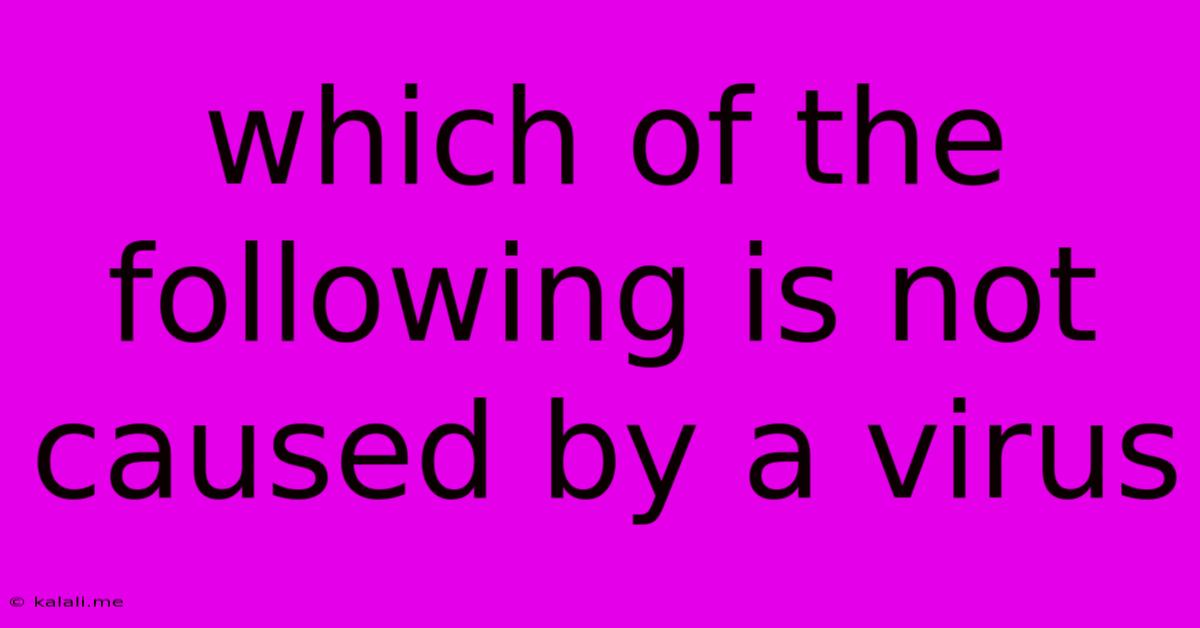Which Of The Following Is Not Caused By A Virus
Kalali
Jun 12, 2025 · 3 min read

Table of Contents
Which of the Following is NOT Caused by a Virus? Understanding Viral and Non-Viral Diseases
Many illnesses are caused by viruses, tiny infectious agents that invade our cells and replicate, causing a range of symptoms. However, not all diseases are viral in origin. This article will explore common misconceptions about viral illnesses and highlight examples of diseases not caused by viruses. Understanding the difference is crucial for appropriate diagnosis and treatment.
The question "Which of the following is NOT caused by a virus?" requires context – a list of potential diseases. However, we can explore several categories of non-viral diseases to clarify the distinction. Let's delve into some common examples:
Non-Viral Illnesses: A Closer Look
Several types of diseases are not caused by viruses. These include:
1. Bacterial Infections:
Bacteria are single-celled microorganisms, different from viruses in their structure and function. While both can cause illness, bacteria are larger and more complex. Examples of bacterial infections include:
- Strep throat: Caused by Streptococcus pyogenes, a bacterium that infects the throat and tonsils.
- Tuberculosis (TB): Caused by Mycobacterium tuberculosis, a bacterium affecting the lungs and other organs.
- Pneumonia: Can be caused by various bacteria, leading to lung inflammation.
- Food poisoning: Often caused by bacteria like Salmonella or E. coli contaminating food.
Understanding the differences between bacterial and viral infections is important for choosing the correct treatment. Bacterial infections are often treated with antibiotics, while antiviral medications are used for viral infections.
2. Fungal Infections:
Fungi are eukaryotic organisms, distinct from both bacteria and viruses. They can cause a range of infections, from superficial skin conditions to systemic diseases. Examples include:
- Athlete's foot: A common fungal infection of the skin on the feet.
- Ringworm: A fungal infection causing itchy, circular rashes on the skin.
- Candidiasis (Yeast infection): Caused by Candida fungi, affecting various parts of the body.
- Histoplasmosis: A fungal infection affecting the lungs, often acquired through inhalation of spores.
Treatment for fungal infections typically involves antifungal medications.
3. Parasitic Infections:
Parasites are organisms that live on or in a host and benefit at the host's expense. These can range from microscopic protozoa to larger worms. Examples of parasitic infections include:
- Malaria: Caused by Plasmodium parasites, transmitted through mosquito bites.
- Giardiasis: Caused by Giardia parasites, often contracted through contaminated water.
- Tapeworm infection: Caused by ingesting tapeworm eggs or larvae.
- Toxoplasmosis: Caused by the parasite Toxoplasma gondii, often found in undercooked meat.
Effective treatment for parasitic infections often depends on the specific parasite and can involve antiparasitic medications.
4. Genetic Disorders:
These conditions result from mutations or abnormalities in an individual's genes. They are not caused by infectious agents like viruses, bacteria, or fungi. Examples include:
- Cystic fibrosis: A genetic disorder affecting the lungs and digestive system.
- Sickle cell anemia: A genetic disorder affecting red blood cells.
- Down syndrome: A genetic condition causing developmental delays and intellectual disabilities.
- Hemophilia: A genetic disorder affecting blood clotting.
Genetic disorders often require specialized medical management and therapies.
5. Autoimmune Diseases:
In autoimmune diseases, the body's immune system mistakenly attacks its own tissues and organs. These are not caused by an external infectious agent. Examples include:
- Rheumatoid arthritis: An autoimmune disease causing joint inflammation.
- Type 1 diabetes: An autoimmune disease affecting insulin production.
- Multiple sclerosis (MS): An autoimmune disease affecting the nervous system.
- Lupus: An autoimmune disease affecting multiple organs and systems.
Treatment for autoimmune diseases often focuses on managing symptoms and suppressing the immune system's attack.
This overview demonstrates the diverse range of illnesses not caused by viruses. Accurate diagnosis is essential for appropriate treatment and management of any disease. If you have concerns about your health, consult a healthcare professional for proper evaluation and guidance.
Latest Posts
Latest Posts
-
Which Of The Following Reactions Is Not A Redox Reaction
Jun 13, 2025
-
In The Third Sentence Of The First Paragraph
Jun 13, 2025
-
California Polytechnic State University Sat Scores
Jun 13, 2025
-
How Many Lakhs Is A Million
Jun 13, 2025
-
Which Of The Following Is Correctly Matched A
Jun 13, 2025
Related Post
Thank you for visiting our website which covers about Which Of The Following Is Not Caused By A Virus . We hope the information provided has been useful to you. Feel free to contact us if you have any questions or need further assistance. See you next time and don't miss to bookmark.